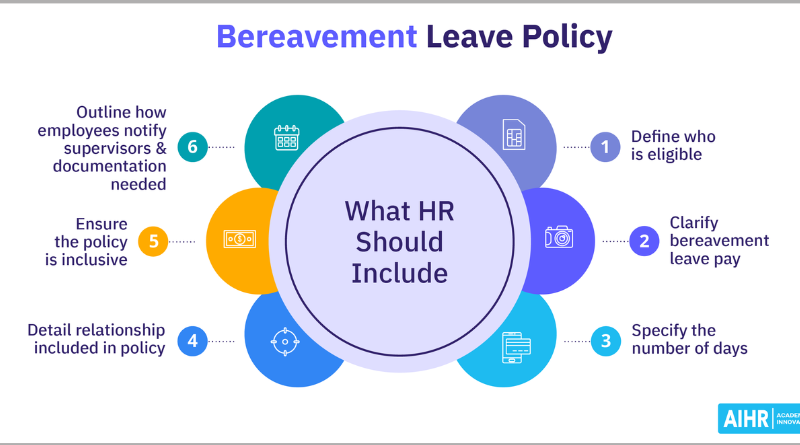Guide to Understanding Bereavement Leave Policies for Employers
Crafting a bereavement leave policy for your organization is an essential step in supporting employees during difficult times. Providing a clear and compassionate leave policy ensures that your staff receives the care they need while coping with the loss of a loved one. It’s crucial to understand the legal implications and ensure your policy aligns with local regulations.
What Is Bereavement Leave?
Bereavement leave, often referred to as compassionate leave, provides employees with the opportunity to take time off from work—either paid or unpaid—due to the passing of a close family member or friend. This leave allows employees to grieve, handle funeral arrangements, and attend memorial services, ensuring they have the necessary time to cope with their loss.
Is Bereavement Leave Legally Required?
While federal law does not require employers to provide bereavement leave, some states have specific regulations governing this type of leave. Here are examples of state-based requirements:
- California: Employers with five or more employees must grant up to five days of bereavement leave after the death of a family member.
- Illinois: Provides up to two weeks of unpaid leave for family death, as well as for losses related to fertility, pregnancy, surrogacy, or adoption, applicable to businesses with 50 or more employees.
- Maryland: Employees are eligible to take up to five days of paid sick leave, or three days specifically for the death of an immediate family member, if employed by a company with 15 or more employees.
- Oregon: Provides up to two weeks of bereavement leave per family member’s death, with a maximum of 12 weeks per year, applicable to employers with 25 or more employees.
It’s important to check your state’s laws for detailed compliance information.
Who Is Eligible for Bereavement Leave?
Eligibility for bereavement leave is typically determined by your company’s policy. Some businesses may limit leave to full-time employees or only for immediate family losses, while others may extend it to cover any employee grieving a loss, such as a close friend or neighbor. A clear and well-defined policy is crucial to prevent misunderstandings and ensure that both employees and employers are aligned on the expectations and processes related to bereavement leave.
Is Documentation Required for Bereavement Leave?
Documentation requirements depend on company policy. If documentation is requested, it’s important to handle it sensitively. Acceptable documents may include an obituary, funeral program, or a written statement from the employee with details of the deceased’s name, date of death, and their relationship to the employee.
How Much Bereavement Leave Is Provided?
Typically, companies provide three to four days of bereavement leave when an immediate family member, like a spouse, passes away.For extended family or friends, fewer days may be allotted. Some employees may extend their leave by using other paid time off (PTO) such as vacation or sick days, or may opt for unpaid leave. Since bereavement leave is not mandated in many states, the exact duration is typically governed by company policy.
Is Bereavement Leave Paid or Unpaid?
Whether bereavement leave is paid or unpaid depends on your company’s policies. Many businesses offer full or partial pay for bereavement leave, though it is not always guaranteed.
Why Offering Bereavement Leave Is Important
Providing bereavement leave demonstrates compassion and support during one of the most difficult times in an employee’s life. Mindy Cassel, co-founder of the Children’s Bereavement Center, explains that offering this type of leave fosters loyalty and appreciation among employees.Cassel emphasized that offering bereavement leave helps alleviate the grieving employee’s stress, creating a compassionate and flexible work environment that supports their adjustment during a difficult time.
Allowing employees to take the time they need to grieve helps them return to work when ready, with greater focus and energy. In contrast, employees who do not have access to bereavement leave may experience emotional challenges that affect their performance and productivity.
Building a Clear and Supportive Bereavement Leave Policy
While not legally required in every state, adopting a comprehensive and well-organized bereavement leave policy is highly recommended. A strong policy should address the following key components:
Eligibility Requirements: Clearly define who is eligible for bereavement leave, such as full-time employees or those with specific family relationships.
Leave Guidelines: Outline how leave is granted based on the relationship to the deceased, distinguishing between immediate and extended family.
Duration of Leave: Specify the number of days employees are entitled to take for bereavement.
Paid or Unpaid Leave: Clearly state whether bereavement leave will be paid or unpaid, ensuring transparency for employees.
Request Procedure: Provide a step-by-step guide on how employees should request bereavement leave, including any required forms or notifications.
Documentation Criteria: List acceptable forms of proof, such as an obituary or a written statement from the employee detailing their loss.
Leave Tracking: Describe how the leave will be monitored and documented within the company’s payroll system to ensure proper records.
Flexibility is a key element, so allow employees to take leave in a way that suits their personal circumstances. Make sure the policy is clearly communicated, included in the employee handbook, and consistently enforced across the organization to ensure fairness.
Supporting Grieving Employees
Beyond having a formal leave policy, there are several ways employers can support grieving employees:
- Educate and Inform: Make sure the team understands the emotional needs of grieving employees.
- Flexible Hours: Offer flexible scheduling to allow employees to manage personal matters.
- Assist with Travel: Help employees with travel arrangements to attend services or be with family.
- Delegate Work: Ensure other team members can handle the employee’s workload during their absence.
- Provide Emotional Support: Pair the grieving employee with a mentor or someone who has experienced similar loss.
- Offer Compensation: Ensure employees are paid during their bereavement leave, if possible.
- Respect Their Privacy: Avoid work-related communication during the funeral or memorial period.
- Send Support: Consider sending flowers, meals, or donations, and offer help with day-to-day tasks such as grocery shopping.
By offering thoughtful support, you not only help grieving employees navigate a difficult time but also foster a positive, empathetic work environment that values and supports its people.



